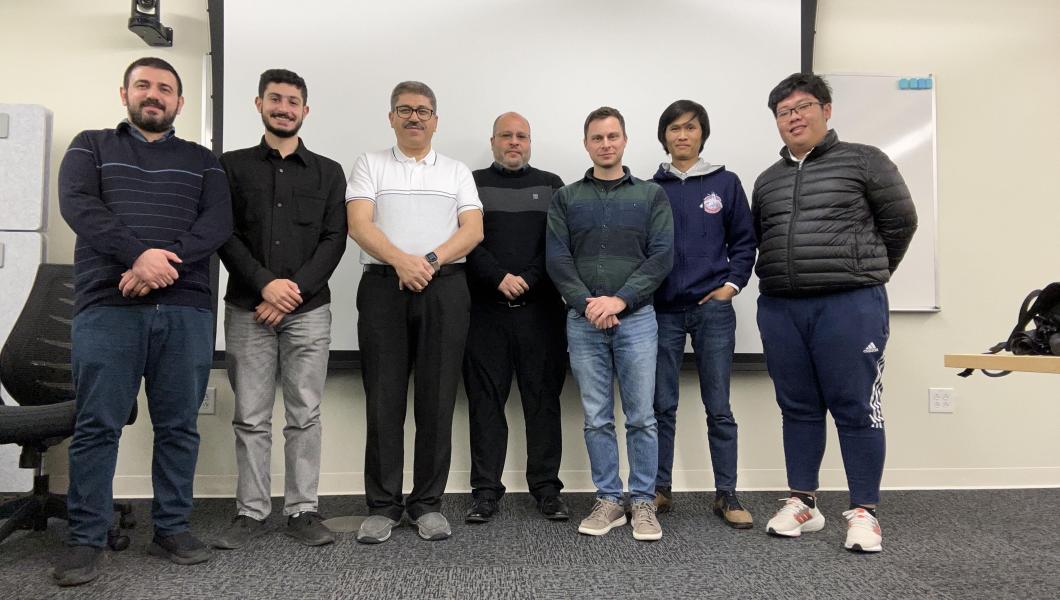NJIT's Chapter of the National Academy of Inventors Takes On Challenges in Global Health Care
Advances in health care research and practice are spurring continuous improvements in society’s capacity to understand, diagnose and treat diseases. The response to COVID-19 is a powerful case in point. And yet the pandemic also highlights the challenge that remains: to provide high-quality health care efficiently, equitably and promptly to underserved people around the globe.
At a recent forum hosted by the NJIT chapter of the National Academy of Inventors (NAI), keynote speaker Roderic Pettigrew, the CEO of engineering health and the executive dean of the Intercollegiate School of Engineering Medicine at Texas A&M University, summed up the global health care conundrum in two terse statements:
“Your zip code is more determinative of your life expectancy than your genetic code,” and, particularly as they involve the spread of infectious disease, “The challenges faced in any location affect every location.”
The workshop, which brought together researchers, health care executives, entrepreneurs and government regulators, discussed potential pathways and collaborations to make health care more efficient and accessible for people across the globe. Panelists focused in particular on the delivery of services and on innovations in preventive, personalized and precision medicine, including advances in point-of-care technologies.
Pettigrew, the founding director of the National Institute of Biomedical Imaging and Bioengineering of the National Institutes of Health, began the session by detailing emerging technologies that stand to make health care more mobile, affordable and efficient. Among many examples, he noted that the National Academy of Medicine provides competitive “Catalyst Awards” to promising new technologies such as cuffless blood pressure devices, automatically refocusing reading glasses, music-based interventions that coordinate movement and wearable systems with personalized AI that provide feedback to help the elderly with balance.
Treena Arinzeh, a distinguished professor of biomedical engineering at NJIT and a recently elected NAI fellow, described her own recent work on damaged joints with what she calls a “simple, safe and cost-effective regenerative strategy" to create tissue from cellulose that will mimic the tissue in cartilage without the need to use cells.
To tap hidden talent, the Foundation Venture Capital Group of the New Jersey Health Foundation, a non-profit, provides what George F. Heinrich, the group’s vice chair and CEO, calls “pre-pre-pre-seed funding,” while also teaching scientists that “entrepreneurship is not a dirty word.”
Speaking directly to innovators and entrepreneurs, Reynold A. Panettieri Jr., director of the New Jersey Alliance for Clinical and Translational Science and vice chancellor for translational medicine and science at Rutgers University, described the tool set of the future: point-of-care devices, minimal touch trials, personal monitors, social media recruitment and real-world evidence.
But the deployment of life-saving and health-improving technologies is possible only with the infrastructure to support it and the governance and policies to guide its adoption, said Atam Dhawan, NJIT’s senior vice provost for research and president of the university’s NAI chapter. He pointed to the creation and distribution of COVID-19 vaccines.
“We needed innovative point-of-care testing technology, large-scale manufacturing of tests and the infrastructure to get those tests, along with vaccines, delivered to patients,” he said, as well as public policies, and in some cases mandates, aimed at stopping the spread.
Commenting on Dhawan’s infrastructure chart, Arunan Skandarajah, a Presidential Innovation Fellow at the FDA and the moderator of the first panel discussion, added that research and innovation must serve diverse users, that infrastructure and resources must be deliverable with limited resources and that governance and policies must “create trust at many levels.”
To scale up health care innovations across a heterogeneous region such as Africa, Nairobi-based Caroline Mbindyo, the CEO of Amref Health Innovations, said entrepreneurs must consider cross-border issues such as differences in infrastructure, consumer literacy and health care worker density from the start.
Steven Schachter, the chief academic officer and program leader for neurotechnology at the Consortia for Improving Medicine with Innovation and Technology (CIMIT) and a professor of neurology at Harvard Medical School, described the creation of RADx (rapid acceleration of diagnostics) Tech in April of 2020. Its goal was to get effective point-of-care tests to the market by the end of the calendar year.
What ensued, he said, was the coordination of “a truly unique blend of private, academic, government and charitable foundations to tackle the problem,” including, among others, five academic research centers with CIMIT at the middle, engineers, manufacturers, federal agencies and the Rockefeller Foundation – a total of 900 experts in all.
“The pandemic galvanized people to work together who had never worked together,” he said, noting that the RADx model, with its high degree of coordination and speed, could be adapted with international partners to solve major unmet health care needs, both acute and chronic.
Jo Carol Hiatt, the vice president for health economics and patient value at the Medical Device Innovation Consortium, a public-private organization focused on advancing the medical device regulatory process, warned of “misaligned and perverse incentives” in the creation and deployment of new technologies and services.
“If funding doesn’t sit in the right place, it’s very difficult,” she said, giving the example of replacing something that happens in a hospital to out-patient or home care, when the funding for it is in the hospital budget. “It’s a real challenge in the U.S. You have to be creative.”
Yukari Manabe, associate director of global health research and innovation at the Johns Hopkins Center for Global Health and a professor of medicine, said health care innovators must look at processes that focus on particular stakeholders, end-users and local capacities, as well as technologies. She pointed to tuberculosis surveillance and treatment in different regions of Uganda that were improved in rural areas, for example, by conducting on-site training for staff, using faster tests and linking laboratories and clinics, among other reforms.
